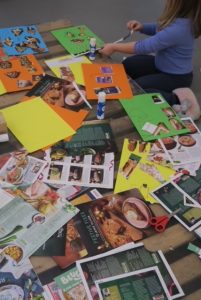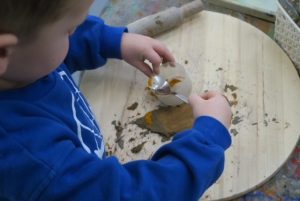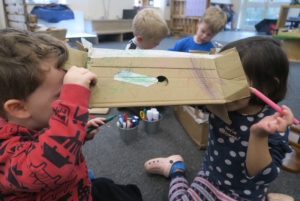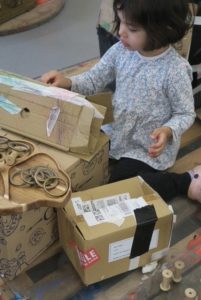Creative Projects in Adel
Our Atelierista Julie over at Adel Inspirations works closely with the children following their interests through child led project based learning. So this week for our blog are taking a look at their most recent project.
The Foods and Shop Project
The children first became interested in food when we started creating collages out of food magazines. Beyond refining their fine motor skills, the food collages sparked up conversations about food, diet and flavours. “My favourite fruit is watermelon”, “Last time we were baking we used a bit too much sugar.” This was the starting point in which our project began.
Even when collaging, each child had their own unique approach when it came to cutting, arranging and selecting pieces. Some focused on categorising different types of food, whilst others gravitated towards certain colour palettes. For some of the older children, they took interest in letters found in the magazines and were able to arrange names and other words with support.

Based on the different conversations about the flavours found in food, the project flowed from collage to spices and clay. The spices allowed the children to utilise their senses, smelling and using touch to figure out how to integrate the spice into their clay creations. They even walked around the room with different spices, inviting other children to smell and make associations. “This one smells like chocolate”, “It smells like oranges!”. During this process, some children also asked where the spices were from. This led us to talk about where our food comes from, and one of those familiar places would be shops.

With the idea of shops in mind, the children thought it would be a good idea to build a food shop together using cardboard boxes and tape. Before beginning construction, the children shared their own shopping experiences with each other. We also used videos and photographs to inform our plan for the shop. This discussion opened up new vocabulary associated with shops, such as ‘cashier’, ‘cash register’ or ‘scanning’. The children ended up deciding that a fridge, shelf and trolley would be the first things to build. Aside from building fine motor skills and engaging in team work, the process of constructing encouraged problem solving. The children discussed and made decisions together about the best way to arrange and construct, sometimes using trial and error to see what would work.

When the shop’s components were built, this area became open for different types of role play. Some children role played as waiters and customers in the cafe area, whilst other children role played as cashiers, scanning products on the checkout machine we had made. This opened up opportunities for maths, where the children bought items and paid with loose parts, counting the correct amounts. Role play allowed for them to explore different roles in society, integrate their own experiences and engage in literacy and maths through play.


The project is yet to be completed, but there are so many directions in which it could grow and expand. Rather than having a strict and set curriculum, following the interests of the children created deeply engaged and proactive learners. With the hundred languages available at our disposal, the opportunities for learning are endless.
Julie